Knots to Know
By Karen Berger
Photographs By John R. Fulton Jr.
Knots and Boy Scouts go together like campfires and cobbler. Here’s how to tie three of the knots required to reach First Class, plus four more that can be very useful.
Knots. It all begins with rope — different sizes, lengths, widths, and strengths, depending on its use.
Ropes used for climbing can bear more than two tons of weight. Thinner, lightweight cords are used for lashings and tying off tent stakes.
Although they are still used in horse packing and sailing, natural-fiber ropes are mostly a thing of the past. Most ropes for outdoor recreation are made of nylon for durability and elasticity.
To prolong the life of your rope, protect it from dirt, sunlight, chemicals, and abrasion. When you store
a rope, coil it following its natural lay. Don’t wrap it around your arm and through your outstretched hand like an extension
cord. Keep it in a bag for storage.
Fortified Square Knot
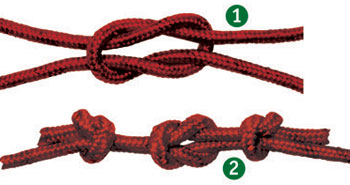 The basic square knot, or “joining” knot, is the first knot many boys learn on the night they join a Scout troop.
The basic square knot, or “joining” knot, is the first knot many boys learn on the night they join a Scout troop.
1) “Right over left and under, left over right and under, then pull.”
2) The fortified square knot strengthens the basic knot by adding an overhand knot to each end, which makes it less likely to slip.
Taut-line Hitch
This is the knot campers use to adjust tension in a tent’s guyline. It works best with cord that is at least ¼-inch thick.
1) Wrap the rope around a secure object such as a tent stake. Bring the leading end under the standing rope and wrap the end around the standing part two times.
2) Finish by bringing the leading rope above the two loops and finish with a half hitch; pull tight.
Grapevine Knot (also known as the Double Fisherman’s Knot)
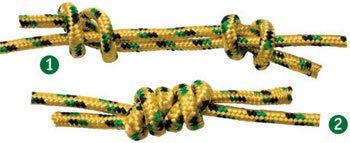 This useful knot ties two ropes of equal diameter securely together. It’s secure enough to be used in rappelling—but can be difficult to untie.
This useful knot ties two ropes of equal diameter securely together. It’s secure enough to be used in rappelling—but can be difficult to untie.
1) Place two lengths of rope parallel to each other. With the leading end of the lower rope, tie two overhand knots around the upper rope; pull the knot tight. With the leading end of the upper rope, tie an overhand knot around the lower rope.
2) Pull the knot tight.
Clove Hitch
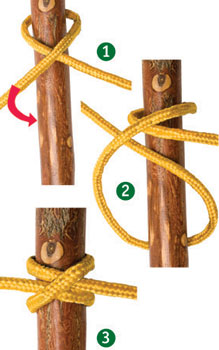 This easy knot can be used to tie a horse to a post. It’s also the knot used to start and finish most lashings. The knot is tied with two loops of rope stacked on top of one another so that they interlock and hold firm. This is one of the quickest knots to learn.
This easy knot can be used to tie a horse to a post. It’s also the knot used to start and finish most lashings. The knot is tied with two loops of rope stacked on top of one another so that they interlock and hold firm. This is one of the quickest knots to learn.
1) Wrap the rope around a post and cross it.
2) Wrap the leading end of the rope around the post again and tuck it under itself below the cross.
3) Pull tight.
Bowline
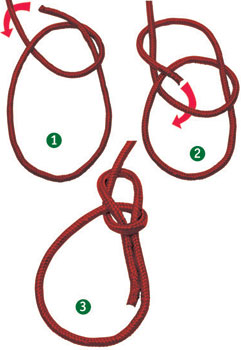 This loop knot is popular among climbers and sailors. It’s a secure knot that will not slip or loosen. In a rescue, a bowline can be tied around a person’s waist so he can be hoisted to safety.
This loop knot is popular among climbers and sailors. It’s a secure knot that will not slip or loosen. In a rescue, a bowline can be tied around a person’s waist so he can be hoisted to safety.
The bowline is often taught using the story of the rabbit and the hunter.
1) Form the rabbit’s hole by making a loop in the rope. Take the leading line (the rabbit) up through the hole.
2) The “rabbit” sees a hunter, runs around the tree (the standing line of the rope)
3) It goes back into the hole. Pull both ends of the rope to finish the knot.
Prusik Knot
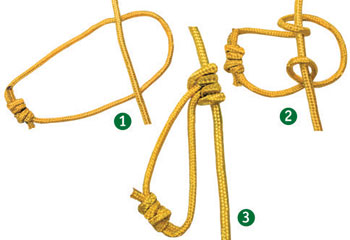 This knot is used by climbers to ascend a rope and by rescuers to raise and lower people and equipment. The climbing rope should be thicker than the accessory cord (usually 5 to 7 millimeters).
This knot is used by climbers to ascend a rope and by rescuers to raise and lower people and equipment. The climbing rope should be thicker than the accessory cord (usually 5 to 7 millimeters).
1) Tie a grapevine knot to make a secure loop.
2) Use a girth hitch (also known as the cow, lanyard, lark’s foot, lark’s head, and strap hitch) to
3) secure the cord with the grapevine knot around another rope.
Chain Sennit
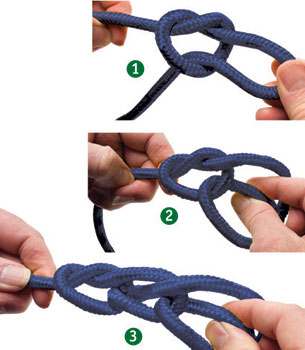 To shorten a long line of rope, such as a painter attached to the bow of a canoe, use the deceptively simple chain sennit. When you need the full length of line, a quick tug frees the entire rope without any kinks or knots.
To shorten a long line of rope, such as a painter attached to the bow of a canoe, use the deceptively simple chain sennit. When you need the full length of line, a quick tug frees the entire rope without any kinks or knots.
1) Make an overhand slip knot.
2) Pull the loose end through to make another slip knot.
3) Repeat as many times as necessary and pull tight.
October 2007 Table of Contents
Copyright © 2007 by the Boy Scouts of America. All rights thereunder reserved; anything appearing in Scouting magazine or on its Web site may not be reprinted either wholly or in part without written permission. Because of freedom given authors, opinions may not reflect official concurrence.